 Intercultural Communication
Intercultural Communication Book contents
- Frontmatter
- Dedication
- Contents
- Preface
- 1 The Survival of the Most Cultured
- 2 The Evolving Culture
- 3 Stereotype – A Necessary Evil
- 4 Non-Verbal Communication – How You Make Them Feel
- 5 A Taxonomy of Diversity
- 6 Intercultural Competence – Creating Yourself
- 7 Diversity Management and Inclusion
- To the Readers
- 7 Takeaways from this Book
- Up and Coming Book from the same Author
- Notes
- Index of Names
- Index of Subjects
- Index of Geography, Culture and Religion
4 - Non-Verbal Communication – How You Make Them Feel
- Frontmatter
- Dedication
- Contents
- Preface
- 1 The Survival of the Most Cultured
- 2 The Evolving Culture
- 3 Stereotype – A Necessary Evil
- 4 Non-Verbal Communication – How You Make Them Feel
- 5 A Taxonomy of Diversity
- 6 Intercultural Competence – Creating Yourself
- 7 Diversity Management and Inclusion
- To the Readers
- 7 Takeaways from this Book
- Up and Coming Book from the same Author
- Notes
- Index of Names
- Index of Subjects
- Index of Geography, Culture and Religion
Summary
It is a sunny morning and you’ve been up since 4 am, getting ready for an interview for your dream job. You’ve spent a fortune on a good pant suit, your shoes couldn't be shinier, and you’ve tried your best to put on a natural make-up look. You arrived at the company half an hour earlier than the appointment and, at precisely 9:10, you’re led to the office of the Human Resources Executive. As you enter the room, three people stand up to welcome you. You reach out to shake hands with each of them, and sit down on a chair that appears to be reserved for you. The interview begins with a friendly question: “How are you today?”
It may take about 45 minutes or less for the interview to end, but the fact is: Employers make up their minds about you in just four seconds, starting from the moment you walk through the door. Recruiters only need an extra six minutes to definitely know whether they are going to hire you or not. Their decisions are based on your eye contact, the way you enter the room, shake hands, the way you dress, smile, touch your hair, control your voice, or position your body, etc. It means decisions are made almost as soon as the greetings are over.
In this chapter, we will explore the role of those non-verbal cues and the way they send messages that speak volumes about you, without you uttering a word. We will explore to what extent non-verbal cues can be understood universally, and to what extent they mean different things in different contexts.
The role of non-verbal communication
Non-verbal communication indicates all non-verbal, intentional and unintentional stimuli that have the potential to convey a communication message. In the metaphorical tree of culture, it belongs to the leaf-and-canopy layer. This includes everything in our surroundings as well as what our body communicates. In general, the surroundings include time and space, while the body includes all five senses in interaction: 83 per cent sight, 11 per cent hearing, 3 per cent smell, 2 per cent touch, and 1 per cent taste. Their role in communication is crucial, and this section will discuss them in depth.
The Universal Role of Non-verbal Communication
The majority of literature on non-verbal communication in intercultural context focuses on the differences across cultures.
- Type
- Chapter
- Information
- Intercultural CommunicationAn Interdisciplinary Approach: When Neurons, Genes, and Evolution Joined the Discourse, pp. 123 - 166Publisher: Amsterdam University PressPrint publication year: 2017


